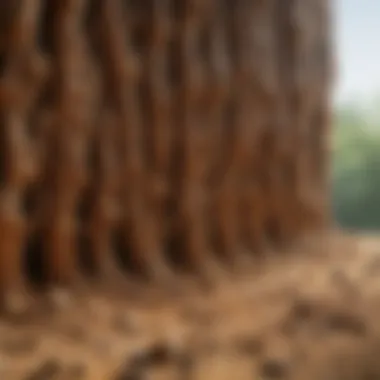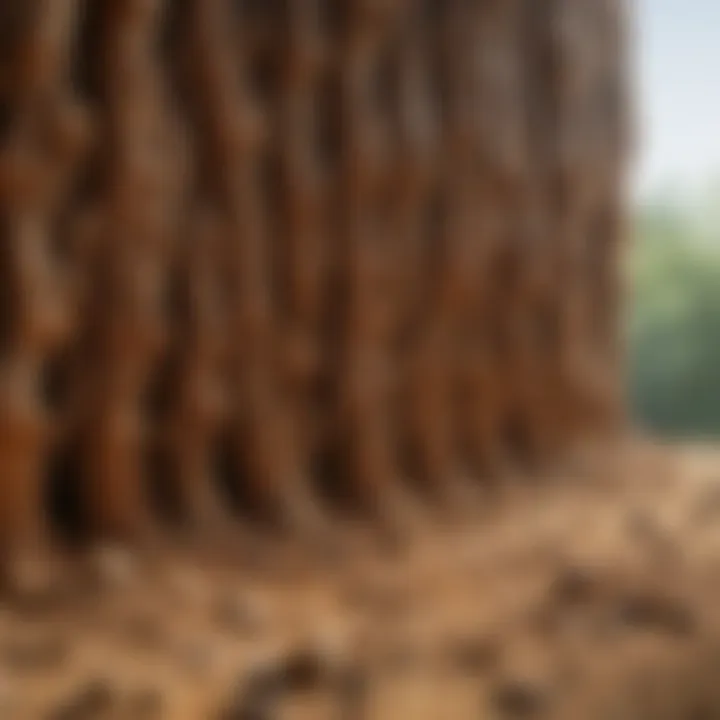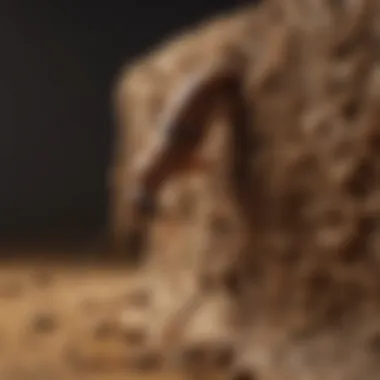Understanding Termite Mud Tubes: Structure & Function


Intro
Termite mud tubes are often overlooked yet they play a fundamental role in the lives of termites. These structures are not merely products of their environment; they are sophisticated paths that allow termites to travel safely between their colonies and food sources. Understanding these tubes is essential for homeowners. By grasping their structure and function, one can adopt effective management and control strategies against termite infestations.
In this article, we will delve into the anatomy of termite mud tubes. We will also explore their significance within the colony structure. Beyond that, we will review preventative measures and control methods that can be employed to maintain a termite-free home. Readers will discover actionable insights and a detailed understanding of how to safeguard their property against these pests.
Understanding the Pest
Identification
Identifying the presence of termite mud tubes is crucial. Typically, these tubes are found in moist areas where wood is available. They are made of soil, wood particles, and saliva, resembling pencil-sized tunnels. Often, these tubes are painted over the walls or made within wood structures.
To effectively identify termites, look for the following signs:
- Presence of mud tubes on walls or foundations.
- Hollowed-out wood structures.
- Swarmers or discarded wings near windows or doors.
Understanding the signs will help in early detection and mitigation efforts.
Life Cycle
The life cycle of termites is key to understanding their behavior. Termites have three main castes: reproductives, workers, and soldiers, each contributing uniquely to colony survival.
- Eggs: Laid by the queen, hundreds to thousands every day.
- Nymphs: Resulting from eggs, they eventually mature into adults.
- Workers: Responsible for foraging food, building, and maintaining the tubes.
- Soldiers: Protect the colony from predators and threats.
- Reproductives: Swarmers migrate to form new colonies.
This cycle can vary significantly depending on environmental conditions, such as moisture level and temperature.
Pest Prevention Strategies
Environment Modification
Creating an inhospitable environment for termites can prevent infestations. Here are some key strategies:
- Reduce moisture around your home. This includes fixing leaks and ensuring proper drainage.
- Store wood and mulch away from the house.
- Keep gutters clean and free from debris.
Physical Barriers
Implementing physical barriers during construction can hinder termite access. Some popular methods include:
- Use stainless steel mesh around foundation areas.
- Consider creating a barrier of sand or gravel that is too dry for termites.
- Ensure proper sealing of entry points, such as utility lines.
Control Methods
Chemical Control
Chemical control remains one of the most effective approaches against termites. When implementing chemical treatments, consider:
- Using liquid insecticides in the soil around foundation walls.
- Applying baiting systems strategically around your property.
- Selecting a termiticide based on your specific infestation type.
Always consult a professional for the right application and safety measures.
Biological Control
Biological control provides an alternative to chemical methods. Here are a few options:
- Nematodes are microscopic worms that kill termites without harmful chemicals.
- Fungal agents that infect and kill termites.
Utilizing natural control methods can reduce environmental impact while managing infestations effectively.
By understanding termite mud tubes, their structure, and functional roles, homeowners can implement appropriate management strategies to protect their properties from infestations.
Foreword to Termite Mud Tubes


Termite mud tubes represent a crucial element in understanding termite ecology and behavior. Recognizing their structure and function provides valuable insight into how termite colonies establish communication and access food sources. These tubes function as highways for termites, allowing them to traverse the environment safely while maintaining protection from predators and harsh weather conditions.
Defining Mud Tubes
Mud tubes are narrow structures built by termites, primarily subterranean species. The tubes are composed of soil, feces, and saliva, blending these materials to create a protective pathway. The construction of these tubes is vital to their survival as they help bridge the gap between their nest and food sources, usually located above ground. Various species of termites, like Eastern subterranean termites and Formosan termites, construct distinct types of mud tubes tailored to their specific habitats.
These tubes can be found in various shapes, typically ranging in size from a few millimeters to several centimeters in diameter. They usually emerge from the soil, ascending vertical surfaces, or along beams and walls, indicating potential termite activity in a structure. Understanding the physical characteristics of mud tubes helps homeowners identify infestations early, which can be crucial for implementing effective management strategies.
Importance of Mud Tubes in Termite Behavior
Mud tubes play an integral role in the behavior of termites, primarily for protection and efficient foraging. These structures not only shield termites from predators, including birds and other insects, but also provide moisture regulation. Termites are sensitive to dry conditions, and these tubes help retain humidity as they transport moisture from the soil to the colony.
By using mud tubes, termites create organized foraging pathways that connect their nest to various food sources like wood, roots, and other plant materials. This organized approach allows for efficient resource acquisition, minimizing the risk of exposure to open air, where they can be vulnerable. The ability to form these conduits speaks to the evolutionary success of termites as a species, enabling them to thrive in diverse environments.
"Termite mud tubes are more than just structures; they are lifelines, enabling survival and communication within colonies."
In summary, understanding termite mud tubes is essential for recognizing the complexities of termite behavior. Homeowners and pest control professionals can benefit from this understanding, allowing them to develop more effective management strategies to prevent potential damage to properties.
Biological Significance of Mud Tubes
Termite mud tubes play a fundamental role in the biological life cycle and behavior of termites. Their construction and usage form a critical aspect of how termites interact with their environment. Understanding this can help in effective termite management and prevention strategies. This significance can be categorized into three primary elements: protection from predators, moisture regulation, and the establishment of foraging pathways.
Protection from Predators
Mud tubes serve as a protective barrier for termites. By building these tubes, termites create a sheltered route between their nests and food sources. This is crucial as it minimizes their exposure to potential predators, such as lizards, birds, and other insects. The tubes are composed of soil, saliva, and fecal matter, which camouflages their presence. Essentially, these structures allow termites to travel safely, unlikely to attract attention from those that might threaten their survival. It is interesting to note that the design and placement of these tubes can often be strategic, ensuring that movement happens in areas where terrestrial threats are minimized.
Moisture Regulation
Maintaining adequate moisture levels is vital for termite colonies. Mud tubes assist in regulating humidity around the termites. The materials used to construct the tubes are effective in preventing moisture loss and maintaining a stable environment. This is particularly important in dry conditions where termites would struggle to survive without adequate moisture. Additionally, the tubes can draw moisture from the ground, which is especially advantageous during hotter seasons or in arid regions. This moisture source is critical not only for the termites’ hydration but also for the growth of fungus, which many termite species farm as a food source. Thus, mud tubes also facilitate a sustainable food cycle within the colony.
Foraging Pathways
The construction of mud tubes also creates distinct foraging pathways for the termites. These tubes connect various food sources, like wood and plant material, to the nest. Termites are social insects, and efficient communication among the colony is essential for their survival. These pathways ensure that worker termites can easily navigate to and from feeding sites. Moreover, they allow for the establishment of foraging routes that can be used repeatedly, leading to effective resource management. In this way, these structures are not only vital in securing food but also serve to enhance the efficiency of the whole colony.
Understanding how termites utilize mud tubes gives homeowners insight into potential infestation management strategies.
In summary, the biological significance of mud tubes cannot be understated. They provide protection from predators, maintain necessary moisture levels, and establish vital foraging pathways. Appreciating these functions can empower homeowners to implement more effective termite control and management strategies.
Types of Termite Mud Tubes
Understanding the Types of Termite Mud Tubes is essential for homeowners and an important element of pest management. Each type of mud tube serves distinct functions and comes from different species of termites. Recognizing these subtleties allows for more informed prevention and treatment processes.
Subterranean Termite Tubes
Subterranean termite tubes are perhaps the most widely recognized variety. These tubes are typically constructed from soil, wood particles, feces, and saliva. This unique composition creates a structure that ensures significant moisture retention, which is crucial for the survival of subterranean termites.
The construction of these tubes benefits the termites by shielding them from predators and environmental stresses. They often range in width, depending on the species and the number of termites utilizing the tube at any given time. Subterranean tubes generally connect a nest to a food source, which is vital for their colony's survival. Homeowners should be vigilant for signs of these tubes leading into structures, as their presence may indicate a serious infestation.
Formosan Termite Tubes
Formosan termite tubes share similarities with subterranean tubes but are generally more robust and complex. Originating from the Formosan termite species, these tubes can rapidly develop and often form large networks that may include multiple nests. Their structure is designed to sustain extreme environments and can be found in coastal areas or regions with high humidity.
Formosan tubes are notable for their high density and use of soil, wood, and excrement. An important consideration for homeowners is that these tubes can cause extensive damage to wooden structures if left unchecked. It is crucial to act swiftly upon detection, as this type of termite can rapidly escalate an infestation situation.
Drywood Termite Tubes
Drywood termite tubes differ significantly from subterranean and Formosan tubes. They typically do not connect to the ground and are often constructed internally within the wood where these termites reside. These tubes are notably smaller and are made primarily from fecal pellets, wood fragments, and saliva.
Because drywood termites can live within the wood they infest, they remain less visible. However, their presence can still be detected by the appearance of small, hardened tubes on the surface of the wood. Damage from drywood termites can be just as severe, often requiring professional intervention due to their concealed nature.
In summary, recognizing the different types of termite mud tubes not only assists in early detection but also in formulating the right strategies for management and prevention. Each type carries unique characteristics and risks, which underscores the importance of tailored approaches to termite control.


Construction of Mud Tubes
The construction of mud tubes is an essential focus for understanding termite behavior and management. These structures not only demonstrate the intricate engineering skills of termites but also highlight their survival strategies and interdependence with their environment. Recognizing how mud tubes are built can provide valuable insights into the life of termites and can inform effective control measures in homes.
Materials Used in Construction
Primarily, termites use soil, fecal matter, and saliva to create their mud tubes. The mixtures of these materials offer multiple advantages. The soil provides strength and stability, while fecal matter helps bind the materials together, making the tubes more durable. Saliva acts as a binding agent, ensuring that the structure holds even under environmental stressors such as humidity or temperature changes.
This combination allows the termites to form a protective layer. The mud tubes act as both a shield against predators and a climate control mechanism that helps regulate moisture. This unique construction process shows how termites adapt and thrive in their ecological niche.
Step-by-Step Tubes Formation
The formation of mud tubes follows a relatively systematic approach. Understanding this process can enlighten homeowners on the extent of a termite infestation. The steps include:
- Selection of Materials: Termites first seek out suitable soil. This soil is typically found near their colonies or in areas where they can quickly forage for food.
- Initial Excavation: After gathering soil and fecal material, termites begin shaping the foundation for the tube. This initial phase consists of excavating soil to form the base of the tube.
- Tube Construction: The termites then begin to mix in their saliva with the gathered materials. This mixture is meticulously packed, forming a pathway. The tube can be narrow or wide, depending on the species and the purpose of the tube.
- Ensuring Stability: They consistently reinforce the structure as they expand, ensuring the tube remains resilient against external pressures and internal movements. The construction may spread across multiple directions, keeping safe pathways to food sources and their nest.
- Maintenance: As environmental conditions change, termites continually repair and maintain these tubes. They will reinforce the walls or widen them as necessary to adapt to the varying climate.
This construction approach highlights the social ordering and teamwork prevalent among termite colonies. All these combined aspects of mud tube construction underscore the sophisticated behavior that termites display, revealing a great deal about their survival strategies.
Environmental Factors Affecting Mud Tubes
Understanding environmental factors is crucial to grasp how termite mud tubes develop and function. These factors significantly influence the structure and durability of mud tubes, which are essential for the survival and efficiency of termite colonies. Notably, soil moisture, temperature variations, and the availability of food sources dictate how and where these tubes are constructed.
Soil Moisture Levels
Soil moisture levels play a vital role in the construction of mud tubes. Termites are sensitive to dehydration. High soil moisture can create favorable conditions for mold and other microorganisms, which termites use to reinforce their structures. Too much moisture, however, may lead to tube collapse. Thus, termites prefer to build their tubes in areas of optimal moisture. They meticulously choose soil types that retain moisture without being overly saturated.
Indications of moisture levels can be visually assessed. If the mud tubes are intact and moist, it may signal a thriving termite colony. In contrast, brittle or dry tubes may indicate stress.
Temperature Variations
Temperature extremes can greatly impact termite behavioral patterns. Warm temperatures enhance termite activity, leading to the quick construction and expansion of mud tubes. In areas of fluctuating temperatures, termites may adjust their tube designs to maintain optimal internal conditions. For instance, when it’s too warm, termites may create wider tubes for better air circulation. Conversely, in colder environments, they might reduce the passage size to conserve heat.
The interaction between temperature and mud tube formation underscores the importance of understanding local climate influences. A rise or fall in temperature can lead to shifts in termite populations, influencing infestations and the potential for property damage.
Availability of Food Sources
Food source availability is another significant factor that affects the construction of mud tubes. Termites primarily feed on cellulose found in wood and plant matter. The proximity of these food sources can dictate the extent of tube networks. If a rich food supply is located far from a colony, termites will construct longer mud tubes to connect to these resources while providing protection from predators.
An abundance of food means more resources are available for tube construction. In contrast, limited food resources can lead to shorter tubes or abandoned constructions. Nutritional scarcity can also force colonies to relocate or adapt their strategies in mud tube construction, impacting their overall efficiency.
"Understanding the influence of soil moisture, temperature, and food availability provides insight into the survival strategies of termites and the potential risks associated with infestations."
Detecting Termite Mud Tubes
Detecting termite mud tubes is a critical step in safeguarding your property from potential termite infestations. Recognizing these structures early on can help in effective management before they cause significant damage to homes. Mud tubes are not just pathways but indicators of underlying termite activity. By understanding how to identify these tubes, homeowners can take informed actions to control termite populations.
Visual Identification Techniques
Visual identification is a primary method in detecting termite mud tubes. Homeowners should regularly inspect areas where termites are commonly found. These areas might include the foundation, crawl spaces, and along walls.
Look for the following characteristics of mud tubes:
- Color and Texture: Mud tubes are usually brown and consist of soil, fecal matter, and digested wood. They present a roughly cylindrical shape, typically about the diameter of a pencil.
- Location: Tubes often run along walls or floors, or may be found on trees and posts.
- Continuity: Healthy tubes will be continuous and may lead directly to wood sources.
By keeping a keen eye on these details, homeowners can detect potential infestations early.
Using Traps and Monitoring Devices
Another effective strategy for detecting termite mud tubes involves utilizing traps and monitoring devices. These tools provide a proactive approach to pest management.
Some effective options include:


- Bait Stations: These traps are placed in the soil around your home. They attract termites and help monitor their activity. A reduction in bait suggests feeding on the structure.
- Moisture Meters: Since termites are typically attracted to moist environments, using moisture meters can help identify areas that might need closer inspection.
Employing these methods not only aids in spotting existing mud tubes but also helps in assessing the risk of future infestations.
Tip: Regular monitoring combined with visual checks increases the chances of early detection of termite activity.
By incorporating both visual identification techniques and technological aids, homeowners can better manage termite threats. Recognizing mud tubes early is crucial to maintaining a healthy living space.
Impact of Mud Tubes on Property
Termite mud tubes can have serious implications for properties, making it essential for homeowners to understand their significance. These structures, created by termites, often indicate the presence of an infestation. As such, recognizing their effects can help in timely intervention, preventing extensive damage.
Structural Damage Indication
Mud tubes are not just a mere inconvenience; they signal critical issues related to property integrity. When termites create these tubes in or around a structure, it is a clear sign that the pests are actively seeking food sources and are likely consuming wood and other materials within the building. This continuous damage can weaken critical structural components, such as beams, floors, and walls, leading to potential safety hazards. Signs of structural damage might include:
- Sagging or warped floors
- Cracked walls
- Doors and windows that stick or don't close properly
Each of these issues can stem from the destructive feeding habits of termites. Homeowners should be vigilant and conduct regular inspections to identify any new tube formations, as this can help in early detection and prevention of further structural damage.
Economic Consequences
The presence of mud tubes can also have significant economic implications. Managing a termite infestation can be costly and time-consuming. The expenses associated with extermination and repairs can quickly add up, particularly if the infestation is allowed to worsen. According to some estimates, termite damage and treatments can total thousands of dollars, depending on the severity of the situation. The key economic factors to consider include:
- Cost of pest control services:
Hiring professionals for termite treatment can lead to significant charges, especially if multiple treatments are necessary. - Repair costs:
Structural repairs might be needed if damage is extensive. Replacing compromised wood or repairing foundation issues can be massive expenses. - Decreased property value:
A home with a history of termite damage may see its market value decrease. Potential buyers often seek properties without pest issues, leading to lower offers or extended time on the market.
"Understanding the implications of termite mud tubes can save homeowners from severe financial strain and protect their investments."
In summary, recognizing the significance of mud tubes on property value and safety is vital. Not only can they indicate access points for termites into a structure, but their presence can also lead to severe financial repercussions. Regular monitoring and effective management strategies are essential for any homeowner.
Management Strategies for Termite Mud Tubes
Managing termite mud tubes is crucial for homeowners and housewives aiming to protect their residences from potential termite damage. Understanding these strategies helps in preventing infestations and mitigating any existing issues. Effective management requires a blend of preventive approaches and professional interventions, ensuring that structures remain intact and safe from these destructive insects.
Prevention Techniques
Prevention is the first line of defense against termite infestations. Here are some techniques that can help minimize the risk of mud tube formation and termite presence:
- Moisture Control: Termites thrive in moist environments. Regularly check for leaks in pipes, avoid standing water, and ensure proper drainage around the home to reduce moisture.
- Proper Landscaping: Keep wood chips, mulch, and other organic materials at least 15 inches away from the foundation of the house. These materials can attract termites.
- Seal Entry Points: Inspect the home for cracks and gaps in the foundation, walls, and around pipes. Sealing these entry points can significantly reduce termite access.
- Regular Inspections: Schedule routine inspections by professionals. They can identify signs of termites before it becomes a larger problem.
- Use of Barriers: Consider installing physical barriers, like metal mesh or sand barriers, during construction. These materials can help prevent termites from entering buildings.
Professional Pest Control Options
In cases where prevention strategies have failed, professional pest control becomes necessary. The following are common options offered by pest control professionals:
- Liquid Termiticides: These chemicals are applied around the foundation of the home. They create a barrier that deters termites from entering.
- Baiting Systems: Bait stations are placed around the property. The termites consume the bait, which contains insect growth regulators, disrupting their growth cycle and eventually leading to colony collapse.
- Fumigation: For severe infestations, fumigation may be necessary. This method involves sealing the home and releasing gas that penetrates all areas, eliminating termites and their mud tubes.
- Localized Treatments: These treatments target specific areas of infestation. Pest control professionals may inject insecticides directly into mud tubes or affected wood.
Understanding and implementing these strategies can greatly reduce the risk of termite damage, ensuring a safer and more secure living environment.
By combining solid prevention techniques with effective pest management methods, homeowners can keep termite mud tubes in check, securing their properties against these pests.
Finale
The conclusion serves as a vital summarization of the main themes discussed regarding termite mud tubes. Understanding these structures is essential for homeowners and housewives who may face termite infestations. Mud tubes are not just mere textures on walls; they indicate the presence and behaviors of termite colonies. Recognizing their significance allows for timely interventions, preventing further damage.
In the context of this article, it is important to reflect on the multifaceted role of mud tubes. They offer a robust understanding of how termites communicate and navigate their environment. Ignoring these structures can lead to severe consequences for property integrity. Being aware of the signs of mud tubes helps in detecting infestations before they escalate.
Recap of Mud Tube Significance
Mud tubes play a crucial role in the survival and efficiency of termite colonies. They provide protection from predators and the elements while facilitating access to essential food sources. Understanding the reason behind the construction of these tubes allows homeowners to appreciate their complexity. It also aids in developing effective pest control strategies. Failing to recognize these mud tubes can lead to substantial structural damage and financial loss.
On a broader scale, recognizing the methodology of pest behavior through mud tubes offers insights into effective management techniques. Strategies aimed at disrupting the construction of mud tubes can be potent in battling infestations, resulting in more targeted and successful pest management solutions.
Future Directions in Pest Management
The future directions in pest management related to termite mud tubes focus on innovative approaches and technologies. Advancements in detection methods, using smart traps and monitoring devices, can provide real-time insights into termite activities. A combination of technology and biological methods may yield more effective management strategies.
Furthermore, educational initiatives focusing on the significance of mud tubes can empower homeowners. Understanding the construction and implications of these tubes can drive proactive measures rather than reactive ones. Collaboration with pest control professionals who employ integrated pest management (IPM) techniques is essential.







